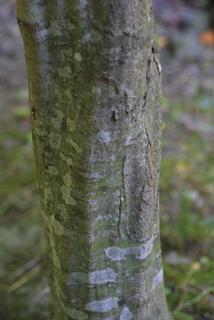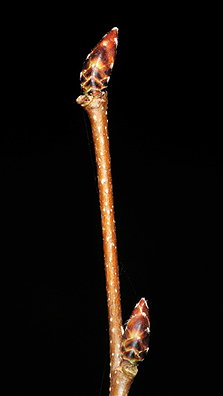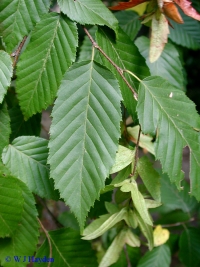 The leaves of Carpinus caroliniana are shaped like a long oval (referred to in botanical books as an oblong ovate shape) with a pointed tip and a base that is often uneven. The edges of the leaves are doubly serrate, which means that the serrations on the edge of the leaf have their own serrations. The smooth, gray bark of the musclewood covers a sinewy, rigid trunk which looks like flexed arm muscles (hence the common name of musclewood). Carpinus fruits are also incredibly beautiful; composed of a series of hanging bracts (modified leaves that are usually associated with a fruiting structure). They hang off the very tip of the branches and blow prettily in the breeze until they are dispersed by birds and insects.
The leaves of Carpinus caroliniana are shaped like a long oval (referred to in botanical books as an oblong ovate shape) with a pointed tip and a base that is often uneven. The edges of the leaves are doubly serrate, which means that the serrations on the edge of the leaf have their own serrations. The smooth, gray bark of the musclewood covers a sinewy, rigid trunk which looks like flexed arm muscles (hence the common name of musclewood). Carpinus fruits are also incredibly beautiful; composed of a series of hanging bracts (modified leaves that are usually associated with a fruiting structure). They hang off the very tip of the branches and blow prettily in the breeze until they are dispersed by birds and insects.
Carpinus caroliniana trees are a good lesson in the value of using scientific names when referring to different species of plants and animals. Carpinus caroliniana are called "musclewood," "ironwood," or "American Hornbeam" interchangeably. Another native Wisconsin tree (Ostrya virginiana), however, is also called "hophornbeam" or "ironwood" which refers to the incredible strength of the wood. I, personally, have had many long conversations with others about "ironwood" (or "hornbeam") only to find out well into the dialogue that the two of us were talking about totally different species of tree! That confusion could have easily been avoided had we used the tree's scientific name right off the bat.
Another very cool thing about Carpinus carolinana especially at this time of year is that they  have pseudo-terminal buds. Instead of just losing their leaves in the fall, they lose their leaves and also the very tip of each shoot so that the bud that looks like the terminal (end) bud is actually the outermost axillary (lateral or side) bud. This phenomenon is present in lots of trees like basswood, elm, and hackberry and is called shoot-tip abortion. Why do trees do this? What is the evolutionary advantage of losing not only your leaves in the fall, but also up to an inch of branch? No one knows! It's an amazing question that people have been trying to answer since the phenomenon was first discovered in 1822.
have pseudo-terminal buds. Instead of just losing their leaves in the fall, they lose their leaves and also the very tip of each shoot so that the bud that looks like the terminal (end) bud is actually the outermost axillary (lateral or side) bud. This phenomenon is present in lots of trees like basswood, elm, and hackberry and is called shoot-tip abortion. Why do trees do this? What is the evolutionary advantage of losing not only your leaves in the fall, but also up to an inch of branch? No one knows! It's an amazing question that people have been trying to answer since the phenomenon was first discovered in 1822.
Would you like to see a musclewood up close and in person? Come to our Riverside Park location and walk to the iron arch on the northwest corner of the building, just past the climbing wall. Planted alongside of the arch are musclewoods and serviceberries! The serviceberries have multiple stems and look more like shrubs, so concentrate on the tree-like plants with the gray muscly-looking bark!





